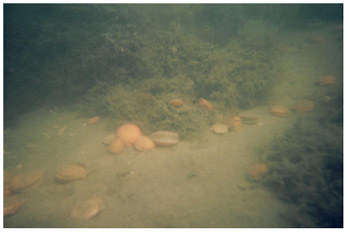Scallop Habitat Assessment Models
The U.S. Environmental Protection Agency’s (EPA) National Health and Environmental Effects Laboratory (NHEERL) recently described a framework and implementation plans for ecological effects research on aquatic stressors, and this work will address the needs identified in the implementation plan for habitat alteration. This research is intended to compliment the Aquatic Stressors Nutrient Program at AED, which is developing models for water quality indicators related to numerous factors, including SAV loss.
The main goal of this research is to quantify the role of habitat in maintaining healthy populations of aquatic-dependent wildlife. To establish the link between habitat and populations, we are developing stressor-response relationships, where habitat alteration is the stressor and scallop populations are the response. We chose to focus on bay scallops  (Argopecten irradians) for this study because of both their societal and ecological importance. Bay scallops are sensitive to changes in water quality and can be an indicator of an ecosystem’s health. This research can also benefit restoration efforts, because not only can it describe habitats where scallop seeding success might be the greatest, but it can also help define changes in the scallop population as a result of restoration efforts.
(Argopecten irradians) for this study because of both their societal and ecological importance. Bay scallops are sensitive to changes in water quality and can be an indicator of an ecosystem’s health. This research can also benefit restoration efforts, because not only can it describe habitats where scallop seeding success might be the greatest, but it can also help define changes in the scallop population as a result of restoration efforts.

How can we use the knowledge of scallop-habitat relationships to guide criteria development and inform/evaluate restoration efforts? For example, if a state’s Designated Use is maintaining healthy populations of fish and wildlife, then what attributes of habitat must be maintained or restored? States and authorized Tribes have some flexibility in establishing designated uses and how to attain those uses. The appropriate uses are determined by taking into consideration the use and value of the water body in question. Many states have designated uses such as “fish and wildlife habitat” (RI and MA) or “maintenance of a healthy, well-balanced population of fish and wildlife” (FL), but do not have clear ways of deciding whether a water body meets those designated uses.
Our question asks: What is the effect of changes in essential habitat on populations of bay scallops? And by essential habitat we mean submerged aquatic vegetation because juveniles attach to grass blades as they make their transition from planktonic larvae to epibenthic adults. They live elevated in the canopy for 1-2 months until they grow larger and have a greater capacity for burst swimming. So, because of their dependence on SAV, juvenile scallops can be considered a habitat-specific species, well-suited for a study attempting to clearly link species dependence on a particular habitat. This research is also particularly relevant, as essential habitat for scallops has been substantially altered and lost in recent years due to eutrophication and disease—so it is critical to protect the SAV habitat that is left. There are also numerous SAV and scallop restoration efforts underway around the Nation, and this research can help guide these efforts and give them endpoints to shoot for.
The relationship between the life support functions or life requisites that a habitat may provide (on the left, Figure 1) and a series of measurable, biologically defined variables (on the right, Figure 1) that can be used to characterize a species’ habitat functions. This series of variables on the right that define the habitat qualities can be used in models we are developing.

We are developing a 3-tiered modeling approach that includes a Habitat Suitability Index (HSI), a demographic population model, and a systems model. Once we have successfully developed and tested these models in New England, we will adapt them to other locales with help from state, regional, federal and academic partners. We expect these models will lead to tools useful for determining habitat-specific requirements for bay scallop subspecies along the Atlantic and Gulf coasts. Other models related to SAV habitat and currents will be developed and used as needed to support the HSI, population and systems models. The current circulation and residence time model developed as part of the Aquatic Stressors Nutrient Program will be used to couple flow and habitat characteristics with their effect on bay scallop larvae and juveniles. The development of these models has several phases, beginning with a conceptual model (Figure 2) and ending with expert reviews and field tests of the models, which will extend beyond FY 2005.

By examining habitat through stressor-response models, we can develop Habitat Suitability Indices for given habitats that can link information on the ability of a given habitat to be able to support bay scallops. By integrating stressor-response models into the population models, we can project how certain population attributes might be affected by a chronic level of stress. A variety of factors feed into the population and systems model that aid in the development of a quantitative risk assessment of populations of bay scallops (Figure 3).

We also hope to use this approach to evaluate which of the three modeling approaches or combinations of modeling approaches works best to define critical habitat attributes for bay scallops that determine if a waterbody achieves the listed designated uses for a particular state. One of the important issues for us to keep in mind is what can a manager realistically measure, what would this criteria look like, and what could we really regulate in the context of habitat alteration and its effect on the target species (i.e., bay scallops). Likewise, it is important to keep in mind how this information be used to refine bay scallop restoration efforts or determine the success of those restoration activities.
![[logo] US EPA](../gif/logo_epaseal.gif)